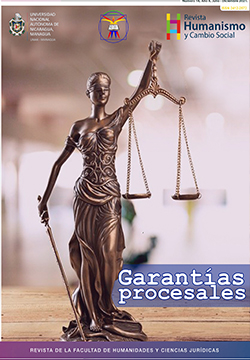Borderline Personality Disorder from a structural perspective
DOI:
https://doi.org/10.5377/hcs.v17i17.13636Keywords:
Personality, Borderline Personality Disorder, Borderline Personality OrganizationAbstract
Personality, can be understood as a complex pattern of psychological characteristics that are expressed in many areas of psychological functioning, involves a range of internal psychological processes, such as patterns of thinking and feeling, ways of experiencing oneself and others, ways of coping and motives. In the personality disorder, the psychology of the person is rigid or inflexible and generates significant anguish to himself or to others. Borderline Personality Disorder (BPD) consists of a pattern of instability of interpersonal relationships, self-image and affections, marked impulsivity, which begins in early adulthood and occurs in a variety of contexts. It has a multifactorial etiology and three dominant factors can be identified that play an important role in its development, such as the presence of a vulnerable and sensitive biologically based temperament; a chaotic and traumatic family environment and triggering environmental events, generally associated with interpersonal relationships. Otto Kernberg’s structural model proposes that BPD is found in a Borderline Organization of Personality, which is characterized by a test of reality that is conserved but vulnerable in intense affective states, the predominance of defenses around spliting and identity diffusion moderate to severe.
Downloads
2510
References
Asociación Americana de Psiquiatría (APA). (2014). Manual diagnóstico y estadístico de los trastornos mentales (DSM 5). Arlington: Editorial Panamericana.
Bateman, A., y Fonagy, P. (2016). Tratamiento Basado en la Mentalización para Trastornos de la Personalidad. España: Desclée de Brouwer.
Behn, A. y Fischer, C. (06 de junio 2021). Mitos y realidades sobre el Trastorno de Personalidad Límite. Ciper. Recuperado el 6 de junio 2021 de https://www.ciperchile.cl/2021/01/15/mitos-y realidades-sobre-el-trastorno-de-personalidad-limite/
Bozzatello, P., Bellino, S., Bosia, M., & Rocca, P. (2019). Early detection and outcome in borderline personality disorder. Frontiers in psychiatry, 10, 710 https://doi.org/10.3389/fpsyt.2019.00710
Crowell, S. E., Beauchaine, T. P., & Linehan, M. M. (2009). A biosocial developmental model of borderline personality: Elaborating and extending Linehan’s theory. Psychological bulletin, 135(3), 495–510. https://doi.org/10.1037/a0015616
Gabbard, G. O. (2014). Psychodynamic psychiatry in clinical practice (fifth edition). Washington D.C.: American Psychiatric Pub.
Gabbard, G. O. (2017). Psychodynamic psychiatry in clinical practice (special edition). Washington D.C.: American Psychiatric Pub.
Kernberg, O. (1987) Trastornos graves de personalidad. Estrategias psicoterapéuticas. México DF: Editorial El Manual Moderno.
Labbé, N., Castillo, R., Steiner, V. y Careaga, C. (2020). Diagnóstico de la Organización de la personalidad: Una actualización teórico-empírica de la propuesta de Otto F. Kernberg. Revista chilena de neuro-psiquiatría, 58(4), 372-383.
Lingiardi, V., & McWilliams, N. (2017). The Psychodynamic Diagnostic Manual–2nd edition (PDM-2). New York: The Guilford Press.
Sawyer, S. M., Azzopardi, P. S., Wickremarathne, D., & Patton, G. C. (2018). The age of adolescence. The Lancet Child & Adolescent Health, 2(3), 223-228. https://doi.org/10.1016/S2352-4642(18)30022-1
Videler, A. C., Hutsebaut, J., Schulkens, J. E., Sobczak, S., & Van Alphen, S. P. (2019). A life span perspective on borderline personality disorder. Current psychiatry reports, 21(7), 51. doi: 10.1007/ s11920-019-1040-1.
Valenciano, L., Rosique, P. Y González, P. (2015). Los preliminares de la Psicoterapia Focalizada en la Transferencia. Revista de Psicopatología y salud mental del niño y del adolescente, 26, 61-72. Wall, K., Kerr, S., & Sharp, C. (2020). Barriers to care for adolescents with borderline personality disorder. Current Opinion in Psychology. (37), 54-60. https://doi.org/10.1016/j.copsyc.2020.07.028
Downloads
Published
How to Cite
Issue
Section
License
Copyright (c) 2022 Universidad Nacional Autónoma de Nicaragua, UNAN-Managua

This work is licensed under a Creative Commons Attribution-NonCommercial-ShareAlike 4.0 International License.




